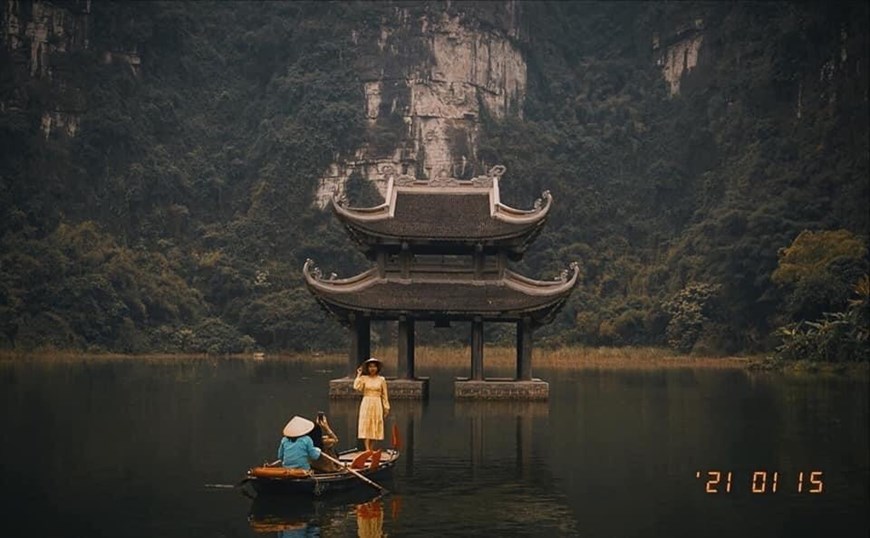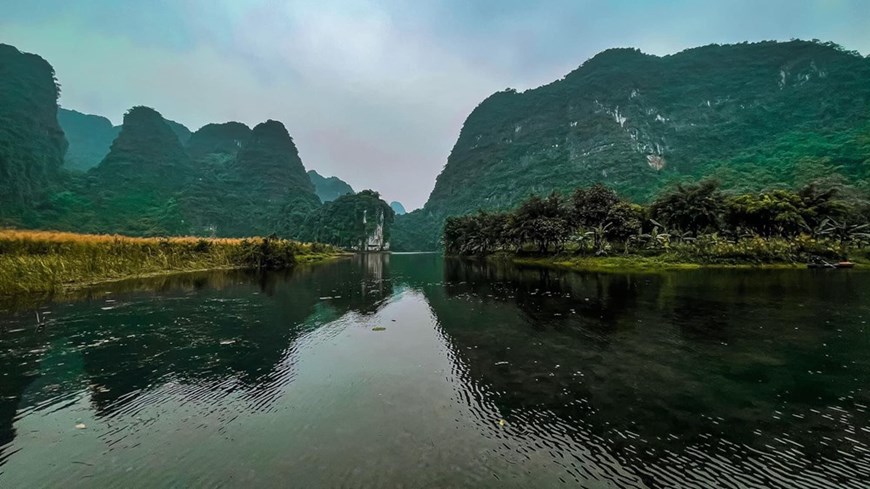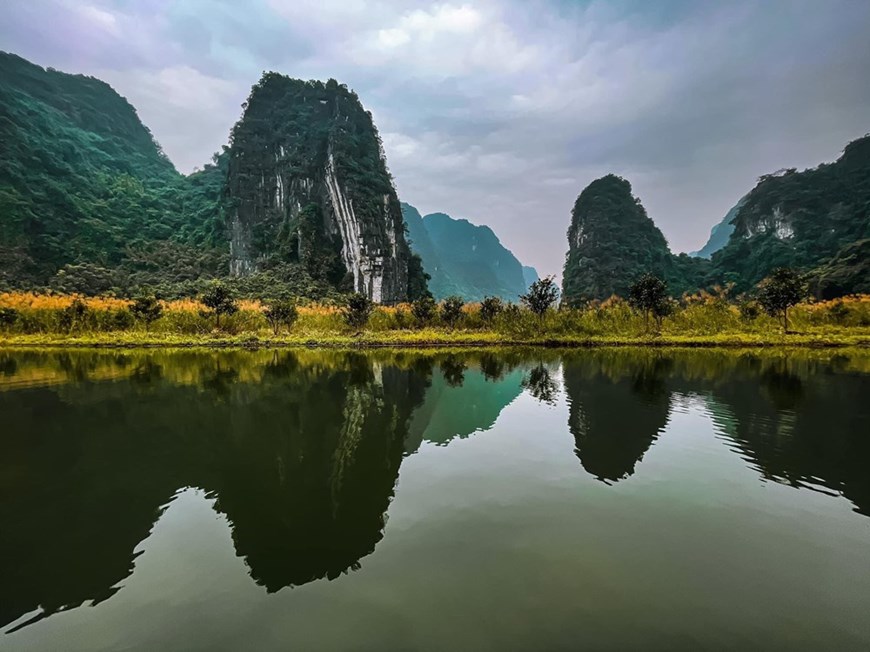-

Mentioning Ninh Binh, tourists not only think of an ancient capital with many historical sites but also an alluring tourism destination. Along with the UNESCO-recognised heritage site of Trang An Landscape Complex and Tam Coc, known as “Ha Long Bay on Land”, Ninh Binh boasts numerous valuable cultural and historical heritage sites such as Hoa Lu ancient capital, Phat Diem stone church, Bich Dong pagoda, Bai Dinh pagoda, Thai Vi temple, and various intangible cultural heritage elements such as festivals, folk singing and culinary culture. This year, Ninh Binh has been chosen as the host of the 2021 National Tourism Year with the theme “Hoa Lu – Thousand-year-old Capital”. (Photo: VietnamPlus)
-

Amid the complicated COVID-19 pandemic, Ninh Binh has worked to ensure a safe environment for tourists and local people by strictly implementing measures to prevent and control any spread of the disease. As the host of the 2021 National Tourism Year, the locality aims to promote itself as an attractive and safe destination for holidaymakers. Accommodation establishments, resorts, and tourist attractions in Ninh Binh have also raised the level of vigilance, strictly implementing pandemic prevention and control measures. The provincial Department of Tourism has also asked tourism businesses to suspend tours to and from pandemic-hit areas to ensure the safety of tourists and local people. (Photo: VietnamPlus)
-

With over 1,400km2 of natural area, Ninh Binh has forests, sea and a diverse system of fauna and flora. The province’s topography encompasses plains and the mountains of the Vietnam northwest mountain range. Ninh Binh also keeps a strategic position for the national military security and social development. Notably, the most well-known tourist destination in Ninh Binh is Trang An Landscape Complex, a World Cultural and Natural Heritage Site. The complex is covered by green forest and bell-shaped karst formations up to 200 metres tall. It is surrounded by rolling mountain ranges and swamps interconnected via an underground stream network. (Photo: VietnamPlus)
-

With unique artistic, geological, geomorphic, and landscape values and traces of pre-historic life, Trang An Landscape Complex was recognised by UNESCO as a World Cultural and Natural Heritage Site in June 2014, becoming the first mixed natural and cultural property in Vietnam. It is also home to a number of attractions recognised as special national relic sites. Foreign geologists have lauded Trang An as one of the world’s most beautiful karst tower landscapes, an “outdoor geological museum” over 250 million years old and a primeval forest with rare flora and fauna. Its karst towers, which have been weathered by wind and water, have turned Trang An into what many call “Ha Long Bay on Land”. (Photo: VietnamPlus)
-

Lying in the complex, the Trang An eco-tourism site has also been honoured as a special national relic. It boasts 250-million-year-old limestone mountains and winding, meandering swamps, valleys, and caves. There are also flooded forests, forests on limestone mountains, and traces of the ancient capital of Hoa Lu. The Trang An cave system is a series of nine caves that you can paddle through on a boating trip down Sao Khe River. This is one of the many limestone formations that make Ninh Binh’s scenery so memorable. Enormous karst formations rise on either side of the river, and scenic rice paddies sprout along the banks. (Photo: VietnamPlus)
-

The Trang An route through Ninh Binh is less busy than the Tam Coc waterway, with fewer tourists and vendors. Even though there are fewer visitors here, you should still arrive early if you want to appreciate this serene waterway. The route is 9.5 miles (15 km) in total. Your guide is an experienced rower, and your adventure takes place in a boat that can typically seat around 4 to 6 passengers. Among the caves, some are decorated with ceramic jars, where locals used to keep their fermenting batches of rice wine. There are three temples along the way — tours typically stop so visitors can get a closer look. (Photo: VietnamPlus)
-

Mua Cave is a well-known check-in place of Ninh Binh. The cave brings one of the best panoramic view of one of the nicest sceneries in Vietnam. Mua view point is located at the top of a steep mountain, but it is worth the 200,000 VND ticket, and the 500 steps up. From the top, you’ll be rewarded with a 360-degree view of Tam Coc valley. The view point is sometimes covered in mist but wait for it to clear, and you’ll marvel at the patchwork quilt of green rice fields below and snaking rivers weaving in, out, and around the ancient karsts. (Photo: VietnamPlus)
-

Winter and Spring are the best seasons to visit Mua Cave, which is described as the “Great Wall of China” in Vietnam. Mua Cave is located in Khe Dau Ha village, Ninh Xuan commune, Hoa Lu district, Ninh Binh province. Together with Trang An ecological tourism complex, the terrain of Mua Cave looks majestic with rolling mountains surrounding a whole large delta like a rampart is protecting the country inside. Visitors have to take 486 stone steps to see beautiful sceneries on the top of Mua mountain. Although it may make you tired because of high steps, it becomes more interesting if you climb slowly and on the way you can take some nice photos. (Photo: VietnamPlus)
-

At the top of the highest mountain there are two roads: One path to the right signed one of The Goddess of Mercy’s shrines and the other to the right signed a dragon with beautiful stonework creates a specific for it – you can witness the one of masterpieces in Ninh Binh. Although Mua Cave is closed at 5pm and the sun sets around 6:30pm, visitors can still enjoy the sky that begins to turn orange when the sun sets behind the mountain top. The highest tower in Mua Cave has Vietnamese traditional architecture. The view is so beautiful from above with a clear blue sky and majestic mountains. (Photo: VietnamPlus)
-

Mua Cave is known as one of the muses of Tam Coc, because at the top of Mua Cave you can have a most realistic and vivid panoramic view of Tam Coc with fields, blue rivers running slowly and lazily, and majestic limestone mountains, the combination makes a wonderful picture. Nature and photo lovers should not miss this place on their journey. From the top, you’ll be rewarded with sweeping panoramas of Tam Coc valley below, with the faint outlines of karsts stretching toward the horizon. After taking pictures, wandering around visitors will find statues of Vietnam’s four sacred animals. (Photo: VietnamPlus)
-

The view of Mua Cave peak is a real reward to visitors with sweeping panoramas of Tam Coc valley below. Tam Coc was in the top 15 “beautiful but little-known” destinations in 2015, as voted by readers of the UK’s The Telegraph newspaper. In early 2018, the image of Ngo Dong River as a soft strip of silk curving around mountains in Tam Coc appeared in Business Insider magazine, heading a list of the 50 most attractive destinations in the world. The golden river welcomes domestic and foreign tourists to the Tam Coc – Bich Dong tourist site. (Photo: VietnamPlus)
-

Two thousand-year-old temples dedicated to the Dinh and Le emperors also add to the attractiveness of Hoa Lu. Other pagodas and temples were built within limestone mountains, of which Bai Dinh is one of the largest in Southeast Asia. Bai Dinh Pagoda is an enormous complex and the largest Buddhist pagoda in Southeast Asia. This singular attraction is a noted pilgrimage stop for Vietnamese Buddhists, and full to overflowing during Buddhist holidays. You’ll need a lot of time to see the whole site. Visitors will be awed by thousands of Buddha statues, elaborately carved bells and a 13-story watchtower, offering sweeping views of the countryside. (Photo: VietnamPlus)
-

Bai Dinh Pagoda has an area of 539 hectares, becoming one of the largest of its kind in Southeast Asia. It was built on the foundation of the ancient Bai Dinh pagoda. The ancient Bai Dinh pagoda (Bai Dinh Co Tu), built thousands of years ago, is located on Bai Dinh Mountain and lies about 800m from the Tam The temple of the new Bai Dinh pagoda area. According to the Vietnamese concept, the ancient Bai Dinh pagoda is located on an area regarded as a sacred land given it is the birth place of the eminent figures of the nation, including kings, saints and divinities. (Photo: VietnamPlus)
-

The pagoda is part of the Trang An Landscape Complex. Located on the highest hill in the region, Tam The (past, present and future) Sanctum is the biggest building in the new Bai Dinh complex. It is 34m high, 59m long and 40m wide, with an inside area of 3,000sq.m. Bai Dinh is considered the largest Buddhist pagoda complex in Vietnam and currently holds several national record-setting relics, including the largest bronze Buddha statue (150 tonnes), the largest bronze bell (30 tonnes), and the largest number of Arhat statues (500). It is expected to attract more tourists from both Vietnam and around the world to Ninh Binh. (Photo: VietnamPlus)
-

In 2010, Bai Dinh Pagoda received Buddhist sarira from India. Not only does the temple offer breathtaking views of the surrounding mountains, visitors can also enjoy a variety of events and activities during their visit. After visiting Ba Dinh Pagoda, many travellers often explore nearby limestone grottoes and hike through the Ba Chua Thuong Ngan forest. Tourist arrivals in Ninh Binh increased 11 percent annually from 2010 to 2019, with revenue growing 23.6 percent. It welcomed around 7.4 million visitors in 2018, including 6.5 million domestic travellers, and earned over 3.6 trillion VND. Due to the COVID-19 pandemic last year, arrivals just reached 2.8 million, or 37 percent of the figure in 2019. (Photo: VietnamPlus)
-

Four statues – three bronze Tam The statues and one Great Buddha Sakyamuni statue – are the pride of “Owners” of Bai Dinh Pagoda. Each statue of Tam The weighs 50 tonnes and measures 12m in height. The 6m-high, 100-tonne Great Buddha Sakyamuni statue, which was casted from the pure bronze bought from Russian by the famous artisans of casting bronze statue in Y Yen, Nam Dinh. A “great bell” with the weight of 60 tonnes was casted and located on the top of the hill on the way to the main sanctuary. The Great Bell is so big that it is estimated if wanting to sound the bell, it will need a big log of wood and four puller the log of wood to prod into the bell. (Photo: VietnamPlus)
Spectacular beauty of Ninh Binh
Located about 90km south of Hanoi, Ninh Binh province is an ideal for vacation-planners thanks to the spectacular natural beauty of various famous tourist sites, including Trang An Landscape Complex - a UNESCO-recognised heritage site.



